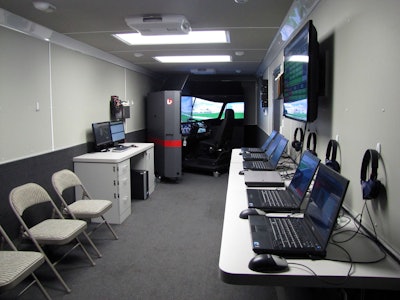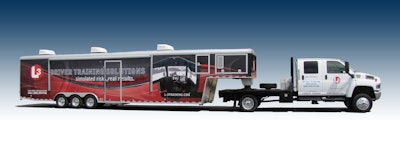 Inside the Mobile Training Center from L-3 Driving Solutions.
Inside the Mobile Training Center from L-3 Driving Solutions.Airline pilots spend many hours in simulators every year to hone their skills. Similar technology is used in the trucking industry but simulation training has traditionally been cost prohibitive for small and mid-size carriers.
Just as software developers now offer products and services through a subscription model with no up-front costs, simulation training has followed suit. Whereas cloud-based software can be used anywhere on any device with an Internet connection, driver simulators require the user to be physically present. The equipment can be mobilized, however.
L-3 Driver Training Solutions, based in Salt Lake City, Utah, is now offering full motion simulation training through a subscription package. Rather than installing simulators inside buildings, the subscription package involves renting a climate-controlled trailer with its latest simulators and professional instructor employed by L-3.
Drivers complete computerized courses first and then use the simulators to apply the topics and learning objectives.
The simulators have a high fidelity motion bay that replicates the experience of road vibration, sliding on wet surfaces and more. A new visual system gives drivers accurate depth perception and life-like graphics, says Matt Derby, marketing communications manager for L-3 Driver Training Solutions.
Fleets that use the mobile training option will typically sign up for one-week to have drivers complete several training courses. L-3 has about 18 different courses to choose from which include fuel management, maneuvering and distracted driving and more. The pricing is determined by the number of courses that fleets sign up for.
Typically, fleets sign up for two courses and train 40 drivers during a one-week period, he says. Each training session lasts four hours.
L-3 has put together several training packages that include several courses each for specific needs in the market. The names of three of these packages are Post-CDL Finishing, Safety Refresher and Post Incident. Each mobile training package costs $12,000.
Real-life results

The Birmingham, Ala.-based company uses the simulators to target behaviors for following distance, speed, recognition of road signs (construction, speeding, low bridge, etc.), maneuvers at intersections and awareness of seasonal hazards.
P&S designs and builds its own scenarios based off the approaching season, says Johnathan Marshall, director of safety.
“We look at data on prior accidents to help determine future focal points. Our instructor attempts to visit each terminal location so that every driver has an opportunity to complete the training,” he says.
Accident rates have decreased since March, 2014, which Marshall credits to simulator training combined with other safety training.
“Typically when a driver finishes our training, he is more acceptable to additional training in the future. Based off of the drivers comments, the technology has improved, the scenarios are more realistic and the scenarios are presented in a professional way to help educate the driver and improve their skill level,” he says.
Don Osterberg has retired from a career in driver training. He implemented a simulation training program while working at one of the largest truckload carriers in North America. The simulation training program, he says, was initially focused primarily on inexperienced commercial drivers which were the majority of the company’s new hires.
A pilot study was conducted using L-3 simulators to train inexperienced drivers to compare results to a control group who went through the legacy training program. Both groups had approximately 300 drivers each. One of the results from the study was a significant decrease in accidents for the test group. Ten percent of drivers trained with simulators were involved in some type of accident during the first 90 days of work compared to 30 percent of the control group.
The most financially-significant outcome was the reduction in training cycle time from 52.5 days for the control group to 32 days for the pilot group, he says. A reduction in training time resulted in increased revenue and decreased costs from fewer instructors and dedicated equipment for training. The pilot group also had a 20 percent better retention rate through the first 90 days of employment, he says, due to an increase in drivers’ confidence.









